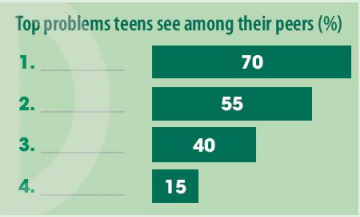Giải Tiếng anh Unit 9 lớp 11 Communication and culture/ CLIL (trang 107) - Global success
- 1Làm xong biết đáp án, phương pháp giải chi tiết.
- 2Học sinh có thể hỏi và trao đổi lại nếu không hiểu.
- 3Xem lại lý thuyết, lưu bài tập và note lại các chú ý
- 4Biết điểm yếu và có hướng giải pháp cải thiện
Everyday English 1
Expressing disappointment and sympathy
(Thể hiện sự thất vọng và đồng cảm)
Listen and complete the conversation with the expressions in the box. Then practise it in pairs.
A. I can sympathise (Tôi có thể thông cảm)
B. I'm sorry to hear that (Tôi rất tiếc khi nghe điều đó)
C. What a pity (Thật đáng tiếc)
Mary: I'm afraid I can’t go to the cinema with you, Andy.
Andy: (1) ____________! I really wanted you to watch the film.
Mary: Maybe another time. My brother is going to see a doctor tomorrow and I promised to go with him.
Andy: (2) ____________. What's wrong with him?
Mary: He's been bullied at school. We think he’s suffering from depression and needs help.
Andy: (3) ____________. l was also the victim of bullying and had a very painful experience. I hope he'll be fine.
Mary: Thank you for your sympathy, Andy.
Everyday English 2
Work in pairs. Use the model in 1 to make similar conversations for these situations. One of you is Student A, the other is Student B. Use the expressions to help you.
(Làm việc theo cặp. Sử dụng mô hình trong phần 1 để tạo các hội thoại tương tự cho các tình huống này. Một trong số các bạn là Học sinh A, người kia là Học sinh B. Sử dụng các biểu thức để giúp bạn.)
1. Student A can't go on a school trip because his/her littte brother/sister is ill and he/she has to take care of him/her. Student B expresses disappointment and sympathy.
(Học sinh A không thể đi dã ngoại vì anh/chị/em bị ốm và phải có em chăm sóc. Học sinh B bày tỏ sự thất vọng và thông cảm.)
2. Student B can’t finish a community project on time because he/she is too stressed preparing for his/ner exams. Student A expresses disappointment and sympathy.
(Học sinh B không thể hoàn thành dự án cộng đồng đúng hạn vì em ấy quá căng thẳng để chuẩn bị cho kỳ thi cuối kỳ. Học sinh A bày tỏ sự thất vọng và thông cảm.)
CLIL 1
Read the text and match each percentage in the chart with ONE social problem mentioned in the text.
(Đọc văn bản và nối từng phần trăm trong biểu đồ với MỘT vấn đề xã hội được đề cập trong văn bản.)
SOCIAL PROBLEMS FACING TEENS IN THE US TODAY

In many countries around the world, it is not easy growing up because teens are dealing with many socialissues. A study carried out by a famous research centre in the US found out that the following were among the most serious ones.
Anxiety and depression: Seven in ten teenagers considered them a serious problem among their peers. The main source of teenagers’ anxiety and depression was social pressure, such as the pressure to look good, to fit in social groups, and to be good at sport.
Bullying: 55% said that bullying was a major problem for teenagers, and around 15% admitted that they had experienced some form of cyberbullying. Girls or younger students were more likely to be victims of bullying.
Poverty: Four out of 10 teens said that poverty was also a major problem for them. In fact, about 20% of the teens in the survey struggled to live below the poverty line every day.
The survey results suggest that more support should be provided to help teenagers avoid serious social issues and enjoy a happier life.
CLIL 2
Work in pairs. Discuss the following questions.
(Làm việc theo cặp. Thảo luận các câu hỏi sau.)
Are the problems mentioned in the text similar to those facing Vietnamese teens?
(Những vấn đề được đề cập trong văn bản có giống với những vấn đề mà thanh thiếu niên Việt Nam đang phải đối mặt không?)
Are there any other problems among teenagers in Viet Nam?
(Có bất kỳ vấn đề nào khác trong thanh thiếu niên ở Việt Nam không?)